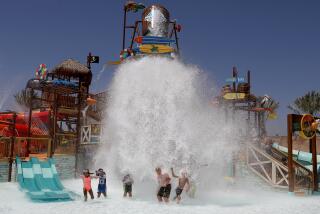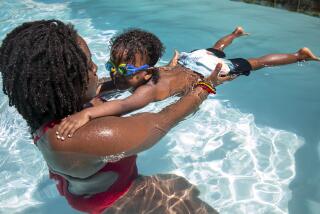Child’s Water Safety Is in the Eye of the Beholder
- Share via
I just looked away for a second. But, as they always say, that was too long. We were walking along the beach in Florida when suddenly, 1-year-old Melanie wasn’t there. Just as I was ready to scream for help, I spotted her, several feet away, happily picking up shells. I still don’t know how she toddled so far, so fast.
It was a lesson learned. Thousands of parents don’t get a second chance. Each year, more than 1,200 children, 14 and under, drown--more than half of them preschoolers--according to the National Safe Kids Campaign. Near drownings send thousands more kids to the hospital and some suffer lifelong disabilities, as a result.
Many of these tragedies happen just like my near miss: a parent gets distracted and looks away for just a moment. That’s all it takes. The experts aren’t kidding when they say you should never lose eye contact with a young child when you are near water. You’ve got to keep your eye on older ones too--even if there are lifeguards on duty.
Forget reading a few pages of that juicy novel you brought along. Forget leisurely sipping a pina colada or a beer. If you’re at a pool, a beach or a lake with your kids--especially if they’re little--you can’t let down your guard at all, warns Dr. Sylvia Micik, a drowning prevention expert and spokeswoman for the American Academy of Pediatrics. Even one drink, she adds, can slow your reaction time.
Micik, who directs a county medical center in La Jolla, notes that in California, drownings are the leading cause of accidental death for young children. Swimming pools are especially dangerous. That’s why if you’re visiting someone who has a pool or staying at a hotel with one, you’ve got to be extra vigilant--even with older kids. Don’t let them swim alone or unsupervised.
My 8-year-old and 6-year-old, both of whom are good swimmers, know that their aunt and uncle in Las Vegas have one pool rule that is never broken: No kids in the pool without a grown-up watching. If they break the rule, they know, there will be no more swimming for the rest of the trip. So, impatient as they are to get in the pool the minute they wake up, they wait.
The kids also know the other pool rule is to keep gates locked behind them--not just closed but locked--to keep the babies out. But all to often, at hotels and private homes, pool gates are left open, Micik says, and toddlers, given any opportunity, will head straight for the water. Even wading pools can be deadly. “A young child can drown in an inch of water,” she notes. If you’re staying somewhere where there is a pool or beach, make sure your child can’t get outside without you.
This is not to say that you can’t have fun with your kids around water. Just be very careful. “Always swim where there’s a lifeguard,” urges Joe Pecoraro, immediate past president of the Huntington Beach-based U.S. Lifesaving Assn., whose members include about 8,000 professional lifeguards. He notes that only a tiny percentage of drownings occur where there are lifeguards.
Of course, the best protection is to teach your children to swim. But even with lessons, children less than 3 are not water safe. If they get frightened, they may panic in the water.
Pecoraro, who oversees 1,000 pool and beach lifeguards for the Chicago Park District, warns that you should never overestimate your children’s swimming ability, especially early in the summer. Make sure they always swim in pairs and insist that they take rest breaks every half hour or so. “You don’t realize how tired you can get just playing in the surf,” he explains. Pecoraro adds that the long breaks from the water our parents insisted we take after eating aren’t really necessary. But your kids shouldn’t pack away a big meal and then set out on an endurance swim, either.
They should also be warned never to dive if they don’t know the depth of the water. Teach your kids to go “feet first, first time,” the American Association of Neurosurgeons suggests. Pecoraro adds that if kids are swimming in a lake, they should swim close to shore. Explain what they should do if they get caught in a riptide or current: “Don’t fight it,” says Pecoraro. “You can’t win. Swim across it.” Have them ask the lifeguards about the currents. And if your kids are boating, no matter how well they swim, insist that they wear Coast Guard-approved life jackets.
It’s a good idea to keep younger kids in life jackets all of the time around the water, Micik suggests. Forget those little inflatable water wings you see everywhere. “They just give parents and kids a false sense of security,” she explains. That goes for any inner tubes or air mattresses, added Pecoraro. Don’t let children take them in deep water if they aren’t strong swimmers. “They won’t keep kids safe,” he warns.
What should you do if you see a child in trouble? Don’t jump in after him or her if you’re not an accomplished lifeguard, advises Pecoraro. You could end up in trouble too. Send someone for help and grab a pole, a towel, a rope or a ring buoy and throw it to them. If you have a pool, keep rescue equipment and a phone poolside, the experts say.
Get the child out of the water fast. If he’s conscious, warm him and make him relax. If he’s unconscious, perform mouth to mouth resuscitation immediately. Use slow, steady breaths (20 per minute for infants, 15 per minute for children). If a drowning child’s life can be saved, it can usually be accomplished by rescue breathing, the American Academy of Pediatrics notes. Hopefully, you’ll never find yourself in that situation. Just keep your eyes on your kids, put that novel away and get out there and play with them. And don’t forget the sunscreen.


